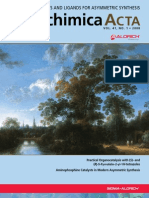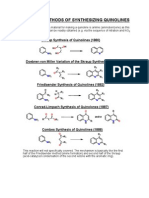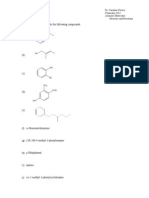24 Nov 06
24 Nov 06
Uploaded by
Subham NandiCopyright:
Available Formats
24 Nov 06
24 Nov 06
Uploaded by
Subham NandiOriginal Description:
Original Title
Copyright
Available Formats
Share this document
Did you find this document useful?
Is this content inappropriate?
Copyright:
Available Formats
24 Nov 06
24 Nov 06
Uploaded by
Subham NandiCopyright:
Available Formats
CHEM 330
Topics Discussed on Nov 6
The Zimmerman-Traxler mechanistic model (NOT "mechanism") for a kinetically controlled
aldol reaction of an achiral enolate containing an oxophilic metal with an achiral aldehyde:
First interaction between an aldehyde and an enolate containing an oxophilic metal:
complex formation
Selective formation of the trans-type complex for steric reasons; e.g., with an E-enolate:
Mt Mt
O O first O O
(the same holds true
R3 interaction R1 H R3 for a Z enolate)
R1 H
R2 R2
generic E enolate trans - complex
Increased electrophilicity of the aldehyde and increased nucleophilicity of the enolate as
a consequence of complex formation:
Mt The enolate is more
The C=O is more O O
electrophilic, due to nucleophilic due to
the formal (+) on O R1 the formal (–) on Mt
H R3
R2
"Double activation" of the aldehyde-enolate complex toward C–C bond formation due to
increased electrophilicity of the aldehyde and increased nucleophilicity of the enolate
Evolution of the aldehyde-enolate complex toward a chair-like conformer that juxtaposes
nucleophilic and electrophilic carbons for C-C bond formation, and in which as many
groups as possible are pseudoequatorial
Existence of two enantiomeric variants of the conformation (transition state model) that permits
C-C bond formation:
R3 H H R3
R2 Mt R2
R1 O O
R1
Mt Mt
O O R1 H R3 O O
a H R2 H b
a and b are enantiomeric structures. In red: incipient C–C bond. Notice the equatorial
1 2
orientation of R and R in these chair-like constructs
note: the coordination sphere of the metal is completed by an appropriate number of
solvent molecules
lecture of Nov 6 p. 2
Principle: the enolate-aldehyde complex will partition equally between the two enantiomeric
conformers a and b above, because a and b possess identical thermodynamic properties
C–C bond formation from structures a and b though a pericyclic mechanism (one involving
a cyclic movement of electrons):
R3 H H
R3
R2 R2 mild OH O
R1 R1 R1 R3
Mt Mt H3O+
O O O O R2
a H H
a metal alkoxide: initial enantiomeric forms of
product of the aldol rx. the anti diastereomer
H R3 H
R2 R2 R3 mild OH O
R1 R1 R1 R3
Mt Mt H3O+
O O O O R2
b H H
Selective formation of the racemate of the anti diastereomer of the aldol product in the reaction
+
between an aldehyde and an E-enolate containing a strongly oxophilic metal such as Li
Selective formation of the racemate of the syn diastereomer of the aldol product in the reaction
+
between an aldehyde and a Z-enolate containing a strongly oxophilic metal such as Li , e.g.:
R3 H H R3
H Mt H
O O
R1 R2
R1
Mt R1 H R3 Mt
O O O O
a aldehyde - Z-enolate complex b R2
R2
notice that only R1 can be equatorial
H
H in transition state structures a and b H R3
R3
H
metal alkoxides: initial R1
R1 products of the aldol rx. Mt
Mt O O
O O R2
R2 OH O OH O
mild mild
R1 R3 R1 R3
H3O+ R2 H3O+
R2
enantiomeric forms of
the syn diastereomer
Diastereoselectivity of a kinetically controlled aldol reaction between aldehydes and enolates
containing strongly oxophilic metals:
E-enolate à anti aldol product Z-enolate à syn aldol product
lecture of Nov 6 p. 3
Principle: because enolate geometry determines which diastereomer of the aldol product is going
to form, it is essential to be able to create E and Z enolates diastereoselectively from any
carbonyl compound.
Ester enolates: stereoselective preparation of E enolates by deprotonation with LDA in
tetrahydrofuran (THF), e.g.:
O–Li
O LDA, –78°C
THF OEt
OEt
Mechanistic model (NOT "mechanism") for E-enolate formation:
equatorial ...!
S S OEt
Li Li S CH3
O N Solvent H
O N
OEt (THF) Mt
EtO O N
S H
only the "red" H is properly aligned with the π*C=O orbital . . .
OEt
S CH3
H Li
O NH(i-Pr)2
Mt =
O N OEt E-enolate • diisopropylamine
S H coomplex
Stereoselective preparation of Z ester enolates by deprotonation with LDA in THF/HMPA: the
Ireland method. E.g.:
O LDA, –78°C O–Li
OEt THF / HMPA OEt
note: HMPA (hexamethylphosphoramide) is an apolar, aprotic, strongly Lewis basic (=donor)
solvent, which — unfortunately — is rather hazardous: see notes of Oct. 2.
Conformational properties of acyclic carbonyl compounds: preference for a syn (eclipsed)
conformation about the sp2-sp3 C–C bond:
lecture of Nov 6 p. 4
θ=0
O
for the generic carbonyl compound shown on the
R
right, the preferred conformation is the one in which G
the R group eclipses the carbonyl oxygen; i.e., the H H
one in which θ(R–C–C–O) = 0
R = alkyl (e.g., Me)
G = H, alkyl, OR', NRR', etc.
Dunitz-Bürgi angle: the angle of ca. 107° between the axes of the large lobes of a π*C=O orbital
and the axis of the σ C=O bond:
α
π*C=O
R1 Dunitz-Bürgi
C O angle: α ≈ 107°
R2
α
You might also like
- Organic Chemistry Crash CourseDocument4 pagesOrganic Chemistry Crash CourseRobert Velázquez LucianoNo ratings yet
- Schaum's Easy Outline of Organic Chemistry, Second EditionFrom EverandSchaum's Easy Outline of Organic Chemistry, Second EditionRating: 3.5 out of 5 stars3.5/5 (2)
- Chemistry: a QuickStudy Laminated Reference GuideFrom EverandChemistry: a QuickStudy Laminated Reference GuideRating: 4.5 out of 5 stars4.5/5 (2)
- Auto-Transformer Design - A Practical Handbook for Manufacturers, Contractors and WiremenFrom EverandAuto-Transformer Design - A Practical Handbook for Manufacturers, Contractors and WiremenRating: 4 out of 5 stars4/5 (2)
- Enolate Stereo ChemistryDocument17 pagesEnolate Stereo ChemistryRasayan Academy - Jagriti SharmaNo ratings yet
- Stabilitas Obat - OksidasiDocument46 pagesStabilitas Obat - OksidasiFadila FadilaNo ratings yet
- Lithium RajendraDocument23 pagesLithium Rajendravijithebest11No ratings yet
- Module3 PDFDocument44 pagesModule3 PDFveenaNo ratings yet
- L9 Deska HomogeneousCatalysis E1130slides To-StudentsDocument49 pagesL9 Deska HomogeneousCatalysis E1130slides To-StudentsSara JaberNo ratings yet
- Unsual Mecanismo DFT Arcilla LeerDocument7 pagesUnsual Mecanismo DFT Arcilla LeerJosé Guadalupe García EstradaNo ratings yet
- Chem 115 Myers: Stereoselective, Directed Aldol ReactionDocument24 pagesChem 115 Myers: Stereoselective, Directed Aldol ReactionChemical MoleculeNo ratings yet
- Substitution V EliminationDocument25 pagesSubstitution V Eliminationsourish kumarNo ratings yet
- PhotochemistryDocument68 pagesPhotochemistryapi-19959578No ratings yet
- Chemistry 108B Exam #2 Cheat Sheet 2Document1 pageChemistry 108B Exam #2 Cheat Sheet 2雪郎かざきNo ratings yet
- Cheat Sheet For Organic Chemistry Midterm 1 2015 1Document1 pageCheat Sheet For Organic Chemistry Midterm 1 2015 1baba yagaNo ratings yet
- Atomic Structure: An Atom of An Element Consists of Nucleus WithDocument51 pagesAtomic Structure: An Atom of An Element Consists of Nucleus WithAnonymous UWxjL2No ratings yet
- Grupos Funcionais Organicos (Ingles)Document1 pageGrupos Funcionais Organicos (Ingles)Jefferson RibeiroNo ratings yet
- Synthesis of Metal Complexes of Hydroxamic AcidDocument1 pageSynthesis of Metal Complexes of Hydroxamic AcidChannal Saif100% (1)
- Organometallic Compounds As IntermediatesDocument17 pagesOrganometallic Compounds As IntermediatesprabhuNo ratings yet
- Organomagnesium (Grignard) and Organolithium ReagentsDocument35 pagesOrganomagnesium (Grignard) and Organolithium ReagentsPaolo PepsNo ratings yet
- C-C Bond Formation: M.C. White, Chem 253 Cross Coupling - 84-Week of October4, 2004Document36 pagesC-C Bond Formation: M.C. White, Chem 253 Cross Coupling - 84-Week of October4, 2004Mohammed AltahirNo ratings yet
- Chapter 3 - part 2Document5 pagesChapter 3 - part 2Dương LinhNo ratings yet
- 1 Insertion / DeinsertionDocument7 pages1 Insertion / DeinsertionJ S.TNo ratings yet
- Reactive Intermediates - LecturesDocument24 pagesReactive Intermediates - Lecturesapi-3771395100% (1)
- Ch3e4 Stereoselective Synthesis MW Handout Reorganised 021111Document51 pagesCh3e4 Stereoselective Synthesis MW Handout Reorganised 021111Kethavath VenkateshNo ratings yet
- Icho37 Prep 7-12Document7 pagesIcho37 Prep 7-12dk9289No ratings yet
- Asymmetric Synthesis - Intro and Diastereoselective RxnsDocument7 pagesAsymmetric Synthesis - Intro and Diastereoselective RxnsIyyappan ANo ratings yet
- O Que É A Corrosão ?: Corrosion and Degradation of MaterialsDocument18 pagesO Que É A Corrosão ?: Corrosion and Degradation of MaterialsPatric PinheiroNo ratings yet
- Chap 3 DaDocument13 pagesChap 3 DaNgọc Huyền NguyễnNo ratings yet
- Synthetic Reagents and Applications: 1.aluminium Isopropoxide 2.N-Bromosuccinimide 3.diazomethaneDocument19 pagesSynthetic Reagents and Applications: 1.aluminium Isopropoxide 2.N-Bromosuccinimide 3.diazomethaneHimanshu PanchalNo ratings yet
- Condensación de CarbonilosDocument22 pagesCondensación de CarbonilosNashely RomeroNo ratings yet
- IIT_Main_Chemistry_Alkanes_MasterDocument26 pagesIIT_Main_Chemistry_Alkanes_Masterjtanvi959No ratings yet
- PCH 311 Organometallic compounds 2Document24 pagesPCH 311 Organometallic compounds 2chinedutosin7No ratings yet
- Pauson Khand ReaktionDocument2 pagesPauson Khand ReaktionOrigamist KryaNo ratings yet
- 4571 Chap13 Migratory InsertionDocument12 pages4571 Chap13 Migratory InsertionkitthiNo ratings yet
- Migratory Insertion: Anionic AnionicDocument3 pagesMigratory Insertion: Anionic AnionicMo MobarkNo ratings yet
- Chapter 7 C-C C-X Bods Formation With Organometallics 2021 22Document71 pagesChapter 7 C-C C-X Bods Formation With Organometallics 2021 22hectormunozroNo ratings yet
- 13. AlcoholDocument7 pages13. Alcoholzohamushtaq789No ratings yet
- Tugas 28-11Document2 pagesTugas 28-11Berliana Dwi SeptianiNo ratings yet
- Prevent DecompositionDocument37 pagesPrevent DecompositionHarman Preet KaurNo ratings yet
- 524chem Metal Carbonyl Cluster Bonding-WDocument33 pages524chem Metal Carbonyl Cluster Bonding-Windu priyaNo ratings yet
- Ligand Exchange Mechanisms: M.C. White, Chem 153 Mechanism - 43-Week of September 24th, 2002Document42 pagesLigand Exchange Mechanisms: M.C. White, Chem 153 Mechanism - 43-Week of September 24th, 2002ririsarista14No ratings yet
- SelectivityDocument4 pagesSelectivitySamik BiswasNo ratings yet
- Advanced Organic Reactions 2000 - WarrenDocument174 pagesAdvanced Organic Reactions 2000 - Warrenshiv57100% (3)
- Enzymatic Synthesis of Amides 2015Document44 pagesEnzymatic Synthesis of Amides 2015bluedolphin7No ratings yet
- Functional Group Transformation Using Sn2 ReactionDocument13 pagesFunctional Group Transformation Using Sn2 Reactionkurniatriwijaya.2410No ratings yet
- Metals Extraction WS 1Document15 pagesMetals Extraction WS 1Samantha JonesNo ratings yet
- Bag. 5 Reaksi OrganometalikDocument45 pagesBag. 5 Reaksi OrganometalikAesyah FadhilahNo ratings yet
- Functional Group Reactions: C Synthesis Strategies, Chem 315/316 / Beauchamp 1Document19 pagesFunctional Group Reactions: C Synthesis Strategies, Chem 315/316 / Beauchamp 1Zia urRehman100% (1)
- Grig NardDocument12 pagesGrig Narddhalashutosh413No ratings yet
- 699325067144095137_xii_-_chem_vol-i - 2024-11-10T055508.444Document15 pages699325067144095137_xii_-_chem_vol-i - 2024-11-10T055508.444thejaswin67No ratings yet
- Comparison of Alkali and HalogensDocument1 pageComparison of Alkali and HalogensLil ManchesterNo ratings yet
- 07-08-2024Document15 pages07-08-2024f20213135No ratings yet
- 2018 Review IDocument6 pages2018 Review IsophNo ratings yet
- Improved Catalysis and Ligands For Asymmetric Synthesis - Aldrichimica Acta Vol. 41 No. 1Document32 pagesImproved Catalysis and Ligands For Asymmetric Synthesis - Aldrichimica Acta Vol. 41 No. 1Sigma-AldrichNo ratings yet
- Quinoline SynthesisDocument6 pagesQuinoline SynthesisFrancesco TutinoNo ratings yet
- CHM207 TutorialDocument3 pagesCHM207 Tutorialit's miaNo ratings yet
- Structure and ReactionsDocument5 pagesStructure and ReactionsShankar RajaNo ratings yet
- Types of Organic ReactionsDocument31 pagesTypes of Organic ReactionsNurulMAprilia80% (5)
- AdlherdsDocument2 pagesAdlherdsMark Robert MagsinoNo ratings yet
- Chapter 15Document7 pagesChapter 15Rafid InamNo ratings yet
- QB - Unit 1 - Introduction of DisconnectionDocument5 pagesQB - Unit 1 - Introduction of DisconnectionYash MahetaNo ratings yet
- Di- π -Methane RearrangementDocument7 pagesDi- π -Methane RearrangementChandra Reddy75% (4)
- Named ReactionsDocument15 pagesNamed Reactionsabhiramiajith0203No ratings yet
- Friedel Crafts ReactionsDocument6 pagesFriedel Crafts ReactionsjanmanchiNo ratings yet
- C) Trigonal Planar: E-Pent-2-ene Z-Pent-2-ene Z-3-Methylpent-2-ene Z-2-Methylpent-2-eneDocument9 pagesC) Trigonal Planar: E-Pent-2-ene Z-Pent-2-ene Z-3-Methylpent-2-ene Z-2-Methylpent-2-eneJessicaNo ratings yet
- Chemistry of Reactive Intermediate FinalDocument38 pagesChemistry of Reactive Intermediate FinalTefera100% (1)
- ACS Review 18 Enols and EnolatesDocument11 pagesACS Review 18 Enols and EnolatesJana BazziNo ratings yet
- Chem 1140 Ring-Closing Metathesis (RCM) and Ring-Opening Metathesis (ROMP)Document26 pagesChem 1140 Ring-Closing Metathesis (RCM) and Ring-Opening Metathesis (ROMP)Abhishek GuddadNo ratings yet
- 12 - 11-12 Name-Reaction-BTech-III-E-12-10-18Document18 pages12 - 11-12 Name-Reaction-BTech-III-E-12-10-18Mithra SNo ratings yet
- Sn1 MechanismDocument24 pagesSn1 MechanismDian MustikasariNo ratings yet
- Reaksi Alkilasi Friedel-Crafts: Kimia Organik II Jurusan Pendidikan KimiaDocument10 pagesReaksi Alkilasi Friedel-Crafts: Kimia Organik II Jurusan Pendidikan KimiaEkanisaKurniawatiNo ratings yet
- McMurry OC8e EV CH16 PDFDocument23 pagesMcMurry OC8e EV CH16 PDFCrizel RicaroNo ratings yet
- Addition-Elimination Special NotesDocument18 pagesAddition-Elimination Special NotesJawad MughalNo ratings yet
- DPP 02 - Aromatic Nucleophilic Substitution Reactions - pdf-11Document7 pagesDPP 02 - Aromatic Nucleophilic Substitution Reactions - pdf-11JeetNo ratings yet
- Pericyclic Reactions (PY-303) PDFDocument24 pagesPericyclic Reactions (PY-303) PDFrajpurohitbharatNo ratings yet
- Notes On Preparation of HaloalkanesDocument18 pagesNotes On Preparation of Haloalkanesranjana roy100% (1)
- Amines HandbookDocument2 pagesAmines HandbookSuhani SubratNo ratings yet
- Friedel-Crafts Alkylation: (X CL, BR, I)Document2 pagesFriedel-Crafts Alkylation: (X CL, BR, I)kalloliNo ratings yet
- Modern Synthetic Methods - 6 Latest VersionDocument94 pagesModern Synthetic Methods - 6 Latest VersionSankar AdhikariNo ratings yet
- Haloalkanes & Haloarenes: Elimination and SubstitutionDocument38 pagesHaloalkanes & Haloarenes: Elimination and SubstitutionMGoyalNo ratings yet
- Rosenmund Reduction MechanismDocument1 pageRosenmund Reduction MechanismRammohan VaidyanathanNo ratings yet
- Julia Olefination Addition InformationDocument5 pagesJulia Olefination Addition Informationkjaj769No ratings yet
- Synthetic Polymers: Paula Yurkanis Bruice University of California, Santa BarbaraDocument59 pagesSynthetic Polymers: Paula Yurkanis Bruice University of California, Santa BarbaraPatil satyajit100% (1)





















































































